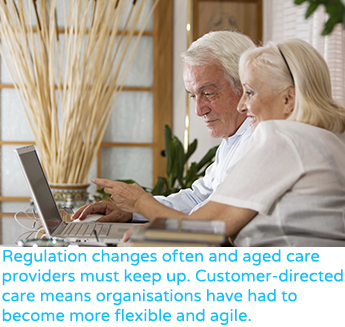Here are three of the key trends we're seeing in the aged care business environment:
- More retirees means fewer skilled workers
As the workforce continues to age, it offers a double-edged sword to the aged care market. On the one hand, there are more customers than ever. On the other hand, the ageing workforce means there are fewer skilled workers to provide the services needed by the growing customer base. The aged care sector has also struggled to attract and retain workers, due to the relatively low pay rates and lack of secure employment opportunities.
In 2010, the then Department of Health and Ageing estimated that the aged care workforce would need to increase between two and three times before 2050 in order to provide care to the growing number of aged care residents. The 2016 National Aged Care Workforce Census and Survey reported that there are over 366,000 paid workers in aged care with a further 68,000 volunteers. - Competition is increasing
With deregulation in place, funding in home care is no longer given directly to service providers. Instead, customers are given the funds and the freedom to choose where they stay and move more frequently, choosing the services they prefer. This has led to an increase in new entrants to the marketplace with about 250 new providers entering the sector since deregulation. This increased competition means customers will likely receive better services, at the same time it puts pressure on providers
A KPMG analysis shows that the home care market is changing fast with new entrants now making up over a third of all providers in key locations. A majority of the new providers are already delivering other types of home care, retirement living or residential care services, and 70 per cent are for profit businesses. Leaders of existing providers that aren't alert to the shifting landscape will struggle to define their own position and retain customers. However, existing providers have many strengths and by setting a clear strategy they can build sustainable businesses and thrive in greater competition. - Increased use of technology in the sector means providers must modernise
Ten years ago, most aged care providers had manual processes in place. This has been changing dramatically since then. Most organizations today have at least accounting software in place and many have clinical care and medication management systems. organizations must be innovative and provide services that are attractive for seniors to join, as the consumer demand has changed with the digital transformation. Increased use of the cloud is reducing the cost of accessing systems, making it easier to manage aged care services. And growing use of big data helps providers understand the customer, and deliver more personalized and advanced care services.
Here are three of the key regulatory trends aged care providers must be aware of to compete effectively in the evolving market.
- Changing payment models
Due to changing demographics, the ratio of people aged 65 and over as a proportion of total population is steadily increasing. Currently, between five and six taxpayers contribute to a senior citizen's care. In the next 20 years, that ratio will fall to between three and four. Governments will thus find aged care more difficult to fund, and implementation of pay-as-you-go strategies will see more funding coming from the seniors themselves. People looking for flexible services will also experience a user-pays model. - Funding crunches mean more consolidation
Total Australian Government expenditure on aged care in 2015-16 was $16.2 billion, up from $15.2 billion in 2014-15. Australian Government expenditure is expected to be $17.5 billion in 2016-17, and increase to just $20.8 billion by 2019 20.1 The 2015-16 Report on the Operation of the Aged Care Act 1997 included the announcement that the Australian Government would invest an additional $649 million per year in 9911 new residential aged-care bed licenses.
Governments looking for budget savings target areas with high funding such as aged care. A recent funding change in Australia affected many aged care providers and care services suffered. Consequently, aged care providers are looking to buffer themselves by cutting costs, and many are doing so by merging together to take advantage of economies of scale. Increased pressure on small players is accelerating consolidation of the fragmented industry with the non-profit/smaller providers being acquired by for-profit/larger organizations. Not only are the smaller ones merging together, the larger for-profits are buying smaller ones and changing the landscape, making it increasingly competitive. - Changing regulation can be hard to manage
Regulation changes often and aged care providers must keep up. Customer-directed care means organizations have had to become more flexible and agile. For example, understanding how to manage new payment systems can be complex. Aged care providers therefore need up-to-date systems that simplify the complexity and drive compliance.
For information on how Epicor helps aged care service providers compete more effectively, don't miss Part II of this blog, coming soon.
